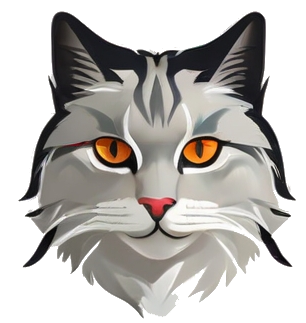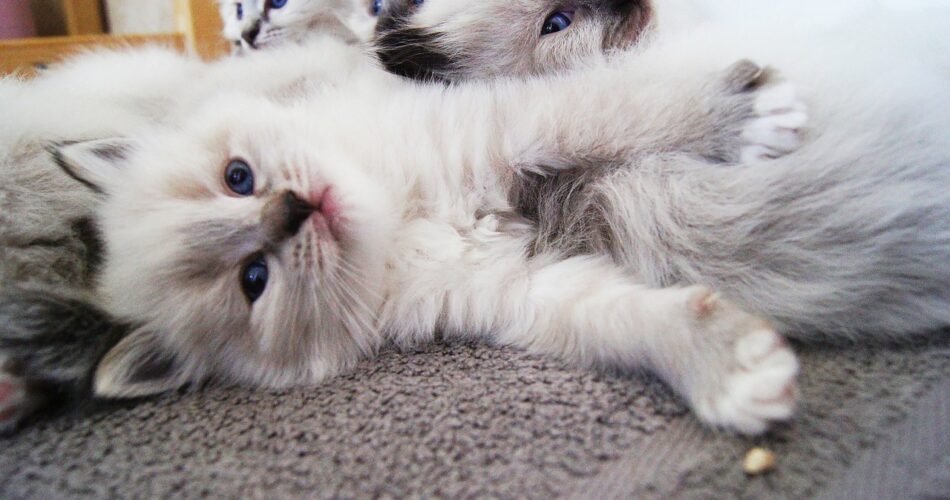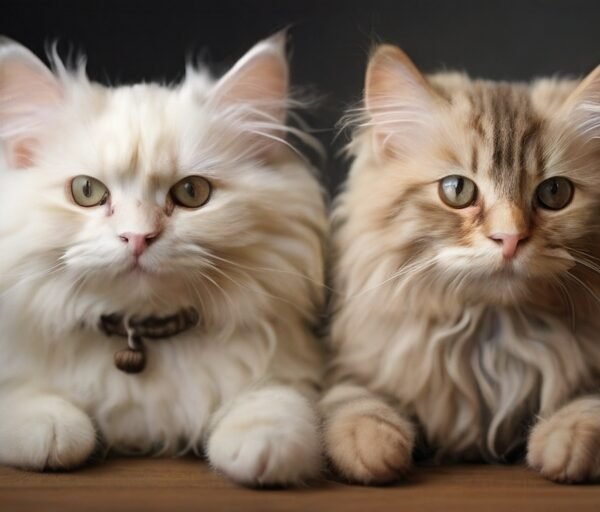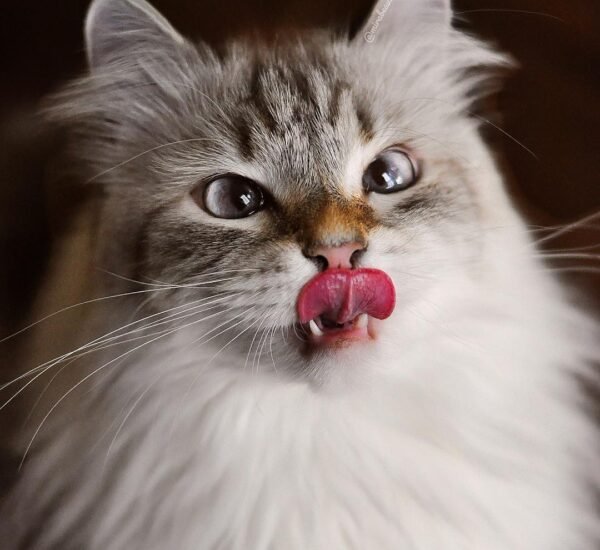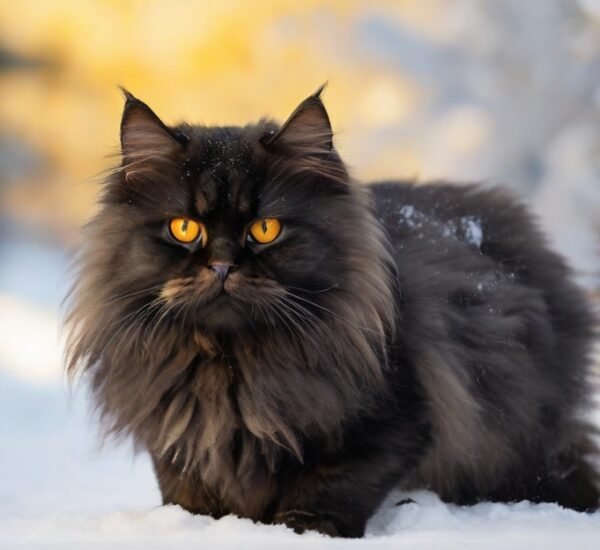Neva Masquerade – a mysterious name for a mysterious beauty! Neva Masquerade is the pointed variant of the Siberian cat and shares many characteristics with this breed.
Appearance
Neva Masquerade is a cat that captivates attention! As the pointed variant of the Siberian cat, this breed delights enthusiasts with its unusual appearance. Long, dense fur with a collar and tufts in the ears, muscular body, and bushy tail give this cat the appearance of a miniature wildcat. It’s no wonder, considering that the Siberian cat, and thus Neva Masquerade, belong to the forest cat group!
How to Recognize the Neva Masquerade Breed
Apart from color, members of the Neva Masquerade breed should not differ from the Siberian cat. As the pointed variant of this breed, Neva Masquerade cats are of medium size, weighing up to nine kilograms. They develop their full weight a bit later and are fully matured only when they reach around three years of age. Their semi-long fur consists of a water-repellent topcoat and plush undercoat. A special feature of this cat is the dense collar around the head and neck! During the summer, Neva Masquerade cats shed their thick undercoat that keeps them warm in Siberian winters, which is why their summer coat appears much shorter and less bushy.
All tufts of fur on the ears and paws, as well as the long, bushy tail, remain the same even during the summer months. Like the Siberian cat, the Neva Masquerade cat has a fairly rounded head with a rounded forehead, large eyes, and medium-sized, wide ears. The eye color of the Siberian cat should be uniform and match the color of the fur, with light blue eye color being usually favored by breeders.
Distinctive Color
Due to their special color, they belong to the unique group of pointed cats. This makes them the only breed of forest cats that are not solid-colored. The so-called “cold” parts of the cat’s body (ears, tail tip, legs, and face) are colored with the base color, while the rest of the body is lighter. The cause of this unusual color is a mutation that leads to defective function of the enzyme tyrosinase, which would otherwise be responsible for producing the pigment melanin. This results in what is known as partial albinism. In the Neva Masquerade breed, a visible contrast between darker and lighter body colors is desirable. The eyes should be intensely blue.
There are also significant differences in the shades of pointed color. For example, in members of the Neva Masquerade breed, all colors of the Siberian cat are allowed as pointed colors, and even tabby stripes are permitted. Solid-colored animals may have faint stripes known as ghost markings. Crossbreeding Somali and Burmese cats has been attempted for some time to achieve new color variations. Here, cinnamon and fawn colors and their lighter variations, chocolate and lilac, are particularly popular.
However, such crossbreeds have a drawback. According to the breed standard, they are not permitted for forest cat breeds such as the Siberian cat. Despite the interesting color, these new color creations are often not recognized by cat breeding clubs. Additionally, there is a risk of introducing hereditary diseases into the genetic pool of the Siberian cat.
Pointed cats like the Neva Masquerade breed come in the following color variations:
Seal-point: Neva Masquerade seal-point cats have a black base color visible at the tips of the body.
Blue-point: The black base color is diluted to become a blue color and is visible on the pointed parts of the body.
Chocolate-point: Neva Masquerade cats with a brown base color are called chocolate-point.
Cinnamon-point: The red base color is visible only on the cooler parts of the body.
Fawn-point: The red base color is diluted into a fawn variation.
Lilac-point: Diluted brown color is called lilac, visible only on the cooler parts of the body.
Cream-point: Diluted red color is called cream. Neva Masquerade cats with cream-point color have body tips in cream color, thus appearing particularly light.
Other well-known pointed breeds are the Birman and Siamese cats. Like all pointed breeds, Neva Masquerade cats are born very light, with darker parts of the coat appearing over time.
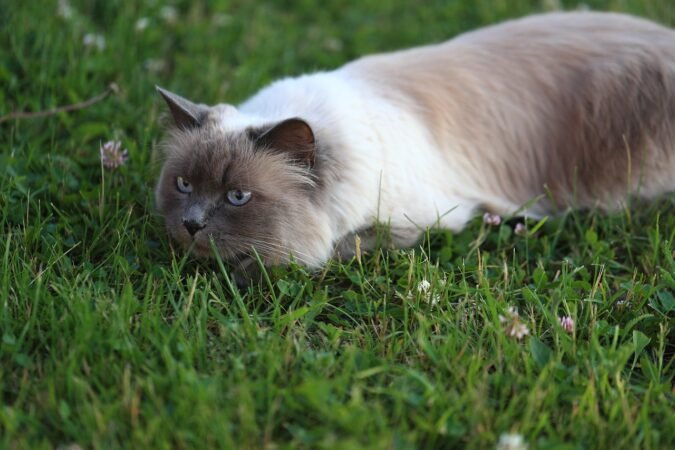
Character
The pointed variant of the Siberian cat, Neva Masquerade, shares the breed standard with that breed. This is reflected not only in the appearance of the cats but also in their character.
Just like the Siberian cat, Neva Masquerade is not only unique in its appearance. Character-wise, it is considered to be straightforward and resilient. Like the Siberian cat, Neva Masquerade is endowed with good instincts, making it an excellent hunter. It enjoys jumping and climbing, loves water, and thrives on being mentally and physically engaged. Keeping it solely indoors is therefore not ideal for this active pet. A secured balcony or garden is a must!
These cats are very intelligent and curious, so consistent training is essential! Intelligence-boosting toys and clicker training are suitable for mentally stimulating your pet. Food puzzle games are also welcome.
Care and Maintenance
The long, dense fur of Neva Masquerade cats gives them a mysterious and distinctive look, but it can be demanding to maintain. Fortunately, they mostly take care of their shorter, summer coat themselves, but during the winter months and shedding season, owners need to brush their pet occasionally. After winter, these cats almost completely shed their thick undercoat. Grooming can prevent hair on clothing and furniture and reduce the risk of gastrointestinal issues due to ingested hair. Applying malt paste or appropriate treats, as well as cat grass, can support the natural passage of hair before hairballs form.
As very active pets, Neva Masquerade cats enjoy outdoor life. They won’t mind going out in rain or snow. Intelligent cats love to sneak through bushes, climb, and ambush birds, and they are considered good hunters. Although they can live in an apartment with enough activity, the perfect home for these pets is a house with a fenced garden where these active cats can run around. Consider getting a large scratching post so your pet doesn’t decorate your new furniture with its claws.
Nutrition
Additionally, appropriate nutrition is the best guarantee for a long and healthy life for your cat. As carnivores, cats need a diet rich in healthy proteins. They can only digest a small amount of carbohydrates. For you as a cat owner, this means that you need to be careful when buying food! High-quality cat food for your pet should contain plenty of meat and a small amount of plant by-products. When you look at the label, meat should be at the top of the ingredient list.
Breeding
Breeding Siberian cats and Neva Masquerade cats is relatively new. Therefore, hereditary diseases of these breeds have not yet been recorded. It is the breeder’s responsibility to ensure that it remains this way! When buying your pet, always choose a professional breeder and do not be swayed by irresponsible breeders offering cats without proper documentation. Their interest is often only profit.
Cat breeding is an expensive hobby. From mating parent cats to pregnancy, birth, and raising kittens, the breeder incurs certain costs that must be covered by the selling price of their cats. This includes mating fees, healthcare, and veterinary costs, including all tests for hereditary diseases, good nutrition, membership in a cat breeding club, vaccinations for kittens, and much more. However, those who care about the well-being of their cats do not skimp on what is probably the biggest item – veterinary expenses. Responsible breeders regularly take parent cats and kittens for check-ups, ensure basic immunization against the most important infectious diseases, and can provide you with documents.
The price of a Neva Masquerade cat is around 700 euros. It’s always a good idea to visit an animal shelter. Many cats, including pedigree cats, are waiting for a new home there!
History
Systematic breeding of the Siberian cat only began in the 1980s, and breeding in America started in the 1990s. Besides the pointed parts of the coat, Neva Masquerade cats do not differ from Siberian cats. The history of the Neva Masquerade breed is similar to the history of the Siberian cat.
Long-haired cats have always been a significant part of the domestic cat population in Russia and Siberia. The reasons for this were long debated in research circles. While some scientists speculated about an independent mutation, others believed there was crossbreeding with long-haired animals from the Orient. The name Siberian cat referred to these muscular domestic cats with abundant, soft fur. They were clearly distinguishable in build and fur texture from the African wildcat, considered the ancestor of all domestic cats.
For this reason, it was long assumed that Caucasian wildcats were close relatives of Siberian cats and that they did not originate from the wildcat. However, a research team from the University of Oxford discovered a few years ago that all domestic cats found on five continents originate from the African wildcat.
Long-haired cats were rare in Europe until the 19th century. It’s no wonder that long-haired cats from Siberia caught the eye of traders and travelers, who imported them to Europe. Siberian cats were described in Brems Tierlebena’s edition from 1864, after which they sporadically appeared in European publications. Long-haired animals from Siberia were also part of the first cat show at London’s Crystal Palace in 1871. After that, the breed fell into oblivion. There were various reasons for this. Long-haired cats were rare, so they often interbred with each other. The Siberian cat was lost in the gene pool of popular breeds such as Persian cats. The political situation in Soviet Russia led to Russia being removed from the list of breeders of the breed.
From the 1980s onwards
However, in the 1980s, breeding Siberian cats and, with it, breeding Neva Masquerade cats, experienced a revival. In 1985, experimental breeding began in the German Democratic Republic (DDR). From 1986 onwards, long-haired cats were seen for the first time at exhibitions. In 1987, the official recognition of the breed, then called the Siberian forest cat, followed. The same year, the first breeding pair of this breed arrived in West Germany. After the first registered litter in 1989, the breed found more and more fans.
At the same time, systematic breeding began in Russia, from where the first specimens were exported to America in 1990. However, the high cost of importing from Russia meant that the population of Russian long-haired cats in the US remained relatively small.
Today
Today, the Siberian cat is bred worldwide. Its name was changed from the Siberian forest cat to the Siberian cat in 1991 to better distinguish it from the Norwegian forest cat. The breed was officially recognized by the World Cat Federation in 1998. Depending on the umbrella organization, the pointed variant, which has been called Neva Masquerade for many years, is bred independently. In simple terms, only Neva Masquerade cats are allowed to mate with each other; crossing Siberian cats of other colors is undesirable.
This, of course, leads to an extreme reduction in the gene pool and an increased risk of developing hereditary diseases. Since the gene for the pointed pattern is recessive and can remain unrecognized in the gene pool for many generations, Neva Masquerade can spontaneously appear in a litter of solid-colored parents. However, there is already a genetic test for pointed mutations, so breeders can specifically search for carriers of the popular pointed gene.
